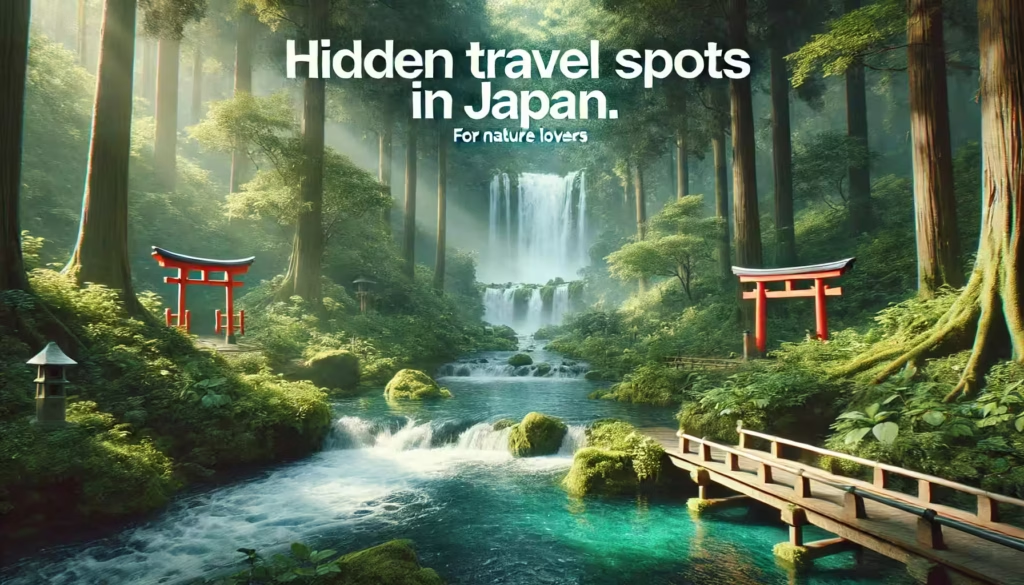Japan is a country that effortlessly blends bustling cities with serene landscapes, where ancient traditions meet modern marvels. While iconic travel destinations like Mount Fuji, Kyoto’s Arashiyama Bamboo Grove, and Hokkaido’s lavender fields often steal the spotlight, there are countless lesser-known gems waiting to be explored.
If you’re a nature lover looking to escape the crowds and immerse yourself in Japan’s tranquil beauty, this guide to hidden travel spots in Japan for nature lovers is exactly what you need.
Hidden Travel Spots in Japan

From secluded waterfalls to untouched forests, Japan’s lesser-known natural wonders offer a sense of adventure and serenity unlike anywhere else.
Let’s embark on a journey to these off-the-beaten-path destinations that will leave you with unforgettable memories and a deeper connection to Japan’s natural splendor. And for more in-depth travel tips and guides, be sure to visit Japan Travel Dreams regularly!
1. Oirase Gorge, Aomori Prefecture
Tucked away in the northernmost region of Japan’s main island, Oirase Gorge is a 14-kilometer stretch of lush greenery, babbling brooks, and cascading waterfalls. This hidden gem in Aomori Prefecture offers a picture-perfect escape for nature enthusiasts looking to experience Japan’s quieter side.
Exploring the Waterfalls
The Oirase Gorge is famous for its series of small yet stunning waterfalls that flow gracefully along the Oirase River. Some of the must-see waterfalls include:
- Choshi Otaki: Often referred to as the “main waterfall,” Choshi Otaki stands at 7 meters high and spans the entire width of the river, creating a powerful yet calming sound of rushing water.
- Kudan Falls: This charming multi-tiered waterfall is surrounded by moss-covered rocks, making it a perfect spot for photography.
- Shiraito Falls: Named for its resemblance to white threads of silk, this delicate waterfall adds a mystical feel to the forested landscape.
Each waterfall has its own character, and as you walk or cycle along the gorge, the sound of flowing water creates a symphony that harmonizes with the peaceful surroundings.
Hiking Trails and Activities
The main trail along the Oirase River is approximately 14 kilometers long and runs between Yakeyama and Nenokuchi near Lake Towada. Here’s what you need to know:
- Difficulty: The trail is mostly flat, making it accessible for hikers of all levels. It’s ideal for a leisurely stroll or a full-day hike.
- Biking Option: For those who prefer a faster-paced experience, rent a bicycle and ride along the riverside trail. There are several rental shops near Yakeyama and Nenokuchi.
- Seasonal Highlights:
- Spring: Fresh greenery takes over the gorge, and the waterfalls are at their peak flow due to melting snow.
- Summer: The gorge offers a cool retreat with its shaded trails and soothing river sounds.
- Autumn: This is arguably the most magical time to visit, as the trees burst into vibrant reds, oranges, and yellows.
- Winter: The gorge becomes a quiet wonderland with snow-draped trees and frozen waterfalls, offering a unique perspective for adventurous visitors.
Nearby Lake Towada
At the end of Oirase Gorge lies Lake Towada, a stunning caldera lake that beautifully complements the gorge’s natural charm. Visitors can:
- Take a scenic boat cruise across the lake to soak in the views from the water.
- Enjoy a lakeside picnic while marveling at the surrounding mountains.
- Visit Towada Shrine, which is tucked away in a peaceful forest near the lake.
Why Visit Oirase Gorge?
- Serene Hiking Trails: The well-maintained trail leads you through a mossy forest with continuous views of waterfalls and the tranquil river.
- Unspoiled Nature: Oirase Gorge’s natural beauty has been preserved, making it one of Japan’s most pristine hiking spots.
- Photographer’s Paradise: Whether it’s the waterfalls, the vibrant foliage, or the play of light filtering through the trees, every corner offers a breathtaking shot.
Travel Tip: Combine your visit to Oirase Gorge with a stop at Lake Towada. For a seamless experience, consider starting early in Yakeyama and ending at Nenokuchi, where you can relax by the lake. If you’re visiting in autumn, plan ahead, as it’s a popular season for local travelers.
For more hidden treasures like this, explore the nature-focused travel guides at Japan Travel Dreams!
Tucked away in the northernmost region of Japan’s main island, Oirase Gorge is a 14-kilometer stretch of lush greenery, babbling brooks, and cascading waterfalls. This hidden gem in Aomori Prefecture offers a picture-perfect escape for nature enthusiasts looking to experience Japan’s quieter side.
Why Visit Oirase Gorge?
- Serene Hiking Trails: The well-maintained trail follows the Oirase River, leading you through a mossy forest dotted with waterfalls. The gentle terrain makes it suitable for all fitness levels.
- Year-Round Beauty: Visit in spring for vibrant greens, summer for refreshing escapes from the heat, autumn for breathtaking foliage, and winter for a snow-draped wonderland.
- Uncrowded Bliss: Unlike heavily trafficked hiking spots, Oirase Gorge remains peaceful, allowing you to truly reconnect with nature.
Travel Tip: Combine your visit to Oirase Gorge with a stop at Lake Towada, a caldera lake nearby. Rent a bike or take a leisurely boat ride to enjoy the full experience.
2. Yakushima Island, Kagoshima Prefecture
If you’re craving an otherworldly escape, Yakushima Island is a must-visit. Known for inspiring the magical forest in Studio Ghibli’s Princess Mononoke, Yakushima is a UNESCO World Heritage site that boasts ancient cedar forests, rugged coastlines, and misty mountains.
What Makes Yakushima Special?
- Ancient Cedars: Hike through moss-covered trails to see the island’s ancient yakusugi cedar trees, some of which are over 7,000 years old, like the revered Jomon Sugi.
- Untouched Wilderness: The dense forests, waterfalls, and abundant wildlife (including Yakushima macaques and deer) make this island feel like a step back in time.
- A Nature Lover’s Paradise: Whether you’re into hiking, kayaking, or stargazing, Yakushima offers plenty of opportunities to explore untouched nature.
Travel Tip: Don’t miss Shiratani Unsuikyo Ravine, where the trails are accessible to hikers of all levels. Bring waterproof gear, as Yakushima is one of the rainiest places in Japan.
3. Goshiki-numa Ponds, Fukushima Prefecture
Nestled in the Bandai-Asahi National Park, the Goshiki-numa Ponds (or Five Colored Ponds) are a collection of volcanic lakes that change colors depending on the season, time of day, and weather. These ponds were formed after the 1888 eruption of Mount Bandai, leaving behind a surreal, almost magical landscape for visitors to explore.
The Five Ponds: Unique Colors and Features
Each of the five main ponds has its own distinct color and beauty, making the trail feel like a treasure hunt as you explore:
- Bishamon-numa: The largest and most popular of the five ponds, Bishamon-numa shimmers with vibrant blue and green hues. It’s a great spot for rowing a boat and taking close-up views of the water’s colors.
- Aka-numa: Known for its reddish tint, this pond offers a striking contrast against the surrounding greenery, especially in the fall when the leaves burst into red and orange tones.
- Midoro-numa: This pond features a beautiful mix of emerald and turquoise shades, reflecting the minerals present in the volcanic soil.
- Tatsu-numa: Smaller and quieter, Tatsu-numa has a reflective surface that mirrors the sky and trees perfectly, creating a peaceful atmosphere.
- Benten-numa: The deep cobalt blue of Benten-numa is mesmerizing and often cited as the most picturesque of the five ponds. It’s a must-photograph stop along the trail.
The Hiking Trail: What to Expect
The Goshiki-numa trail is a gentle 3.6-kilometer path that takes around 1 to 1.5 hours to complete. Here’s what makes it special:
- Easy and Accessible: The trail is well-maintained and suitable for all ages, making it perfect for families and casual hikers.
- Scenic Stops: Wooden viewing platforms and small bridges offer great photo opportunities at every turn.
- Flora and Fauna: Keep an eye out for koi fish swimming in the ponds, as well as seasonal flowers and wildlife. The colorful koi in Bishamon-numa are particularly famous for adding to the pond’s charm.
Seasonal Beauty
The beauty of Goshiki-numa transforms with the seasons, offering a unique experience depending on when you visit:
- Spring: Lush greenery emerges, and flowers begin to bloom, enhancing the vibrancy of the ponds.
- Summer: The bright sunlight brings out the rich blues and greens of the water, making it an ideal time for photography.
- Autumn: Arguably the best time to visit, the colorful foliage perfectly complements the surreal hues of the ponds.
- Winter: While the trail may be covered in snow, the icy beauty of the ponds and the surrounding silence create an enchanting winter wonderland.
Travel Tips for Goshiki-numa
- Start Early: Arrive early in the morning to avoid any crowds and witness the ponds at their most peaceful.
- Bring a Camera: The vibrant colors of the ponds are best captured with a good camera or smartphone.
- Wear Comfortable Shoes: Although the trail is easy, it’s best to wear walking shoes suitable for light hiking.
- Nearby Attractions: Consider exploring nearby Mount Bandai or visiting the historical village of Ouchi-juku to make the most of your trip.
Goshiki-numa Ponds offer a serene and magical escape into nature, showcasing the beauty that Fukushima Prefecture has to offer. Whether you’re an avid photographer, a casual hiker, or someone seeking peace and tranquility, this hidden gem is a must-see on your Japan travel bucket list. For more guides on hidden spots like Goshiki-numa, visit Japan Travel Dreams for inspiration!
Nestled in the Bandai-Asahi National Park, the Goshiki-numa Ponds (or Five Colored Ponds) are a collection of volcanic lakes that change colors depending on the season, time of day, and weather.
Why You’ll Love Goshiki-numa Ponds
- Mesmerizing Colors: The unique mineral content of the water creates stunning hues of blue, green, and turquoise. Each pond has its own distinct color and personality.
- Easy to Explore: The hiking trail that connects the ponds is only about 4 kilometers long, making it perfect for a leisurely stroll.
- Peaceful Ambiance: Unlike more popular nature spots, Goshiki-numa remains relatively uncrowded, even during peak seasons.
Travel Tip: Visit in autumn for a stunning contrast between the colorful foliage and the vibrant waters. Don’t forget your camera!
4. Tottori Sand Dunes, Tottori Prefecture
When you think of Japan, sand dunes might not come to mind—but Tottori Sand Dunes will make you question everything you know about Japan’s landscapes. Located along the Sea of Japan, this surprising natural wonder stretches for 16 kilometers and can rise up to 50 meters high, creating a desert-like landscape unlike anywhere else in the country.
Activities to Try at the Tottori Sand Dunes
The Tottori Sand Dunes are more than just a scenic spot; they offer a range of activities for adventurers and casual explorers alike:
- Sandboarding: If you’re an adrenaline junkie, rent a sandboard and glide down the steep dunes for a thrill that’s like snowboarding but with golden sand.
- Camel Riding: Channel your inner desert traveler with a camel ride along the dunes. It’s a fun and unique way to experience the landscape, especially for families or first-time visitors.
- Paragliding: For an aerial perspective of the dunes and surrounding coastline, try paragliding. The view from above is absolutely breathtaking, offering a bird’s-eye view of the sand dunes meeting the Sea of Japan.
- Scenic Walks: For a quieter experience, take a leisurely walk across the undulating dunes, exploring the rippled patterns and enjoying the peaceful sea breeze.
- Photography: The changing light throughout the day creates dramatic shadows and golden hues on the sand, making this a dream spot for photographers. Early mornings and sunsets are particularly magical.
Nearby Attractions
- The Sand Museum: Located near the dunes, the Sand Museum showcases incredible sand sculptures crafted by world-renowned artists. Each year, the museum features a different theme, making it a fresh experience for returning visitors.
- Uradome Coast: Just a short drive away, the Uradome Coast offers rugged cliffs, crystal-clear waters, and hidden coves perfect for kayaking or sightseeing.
- Tottori City: Explore Tottori City’s markets and eateries, where you can savor local delicacies like fresh crab and pear-based treats, for which the region is famous.
Best Time to Visit the Tottori Sand Dunes
- Sunrise and Sunset: The golden light during sunrise and sunset enhances the natural beauty of the dunes, creating an almost surreal atmosphere. Early morning visits are also great for avoiding crowds.
- Spring and Autumn: These seasons offer mild weather, making it pleasant to explore the dunes without the intense summer heat.
- Winter: While rare, a dusting of snow on the dunes creates a unique and picturesque contrast against the sandy terrain.
Why Visit the Tottori Sand Dunes?
- A Unique Landscape: The dunes are a natural wonder that stands out in Japan’s diverse geography, offering an unexpected and stunning desert-like experience.
- Family-Friendly Activities: From camel rides to sandboarding, there’s something for everyone, making it a perfect destination for families.
- Close to Other Attractions: With the Sand Museum, Uradome Coast, and Tottori City nearby, you can turn your trip to the dunes into a full-day or weekend adventure.
Travel Tip: Be sure to bring sunglasses, sunscreen, and plenty of water, as the sand can reflect sunlight and get quite hot during the day. Visiting early in the morning or late afternoon ensures a more comfortable experience.
The Tottori Sand Dunes are a one-of-a-kind destination that offers adventure, beauty, and tranquility. Whether you’re sandboarding down the dunes, marveling at the art in the Sand Museum, or simply soaking in the natural landscape, this hidden gem is sure to leave a lasting impression. For more hidden wonders across Japan, check out Japan Travel Dreams for additional tips and guides!
When you think of Japan, sand dunes might not come to mind—but Tottori Sand Dunes will make you question everything you know about Japan’s landscapes. Located along the Sea of Japan, this surprising natural wonder stretches for 16 kilometers.
What’s Special About Tottori Sand Dunes?
- A Desert-Like Oasis: These shifting dunes, formed over thousands of years, are the largest in Japan.
- Adventure Awaits: Try sandboarding, camel riding, or simply hiking across the dunes for stunning ocean views.
- Sunrise and Sunset Views: The dunes are particularly magical during sunrise and sunset when the sands reflect vibrant golden and orange hues.
Travel Tip: Visit the Sand Museum nearby, which showcases incredible sand sculptures crafted by artists from around the world.
5. Akiyoshido Cave, Yamaguchi Prefecture
Hidden beneath the rolling hills of Yamaguchi Prefecture lies Akiyoshido, one of Japan’s largest limestone caves. Stretching over 10 kilometers, this otherworldly cavern is a hidden treasure for adventurous travelers.
Why Visit Akiyoshido Cave?
- Underground Marvel: Walk along the illuminated pathways to witness surreal rock formations, stalactites, and stalagmites.
- Unique Atmosphere: The cave’s cool, damp environment provides a refreshing escape from Japan’s summer heat.
- The Limestone Plateau: Above the cave, the Akiyoshidai Plateau offers sweeping views of rolling grasslands, perfect for a scenic hike.
Travel Tip: Wear sturdy shoes and bring a light jacket, as the cave remains cool year-round.
6. Kamikochi Valley, Nagano Prefecture
For those yearning to experience the Japanese Alps without the crowds, Kamikochi Valley is a dream come true. Known for its pristine beauty, Kamikochi is a haven for hikers, photographers, and anyone seeking serenity in nature.
Highlights of Kamikochi Valley
- Stunning Scenery: Crystal-clear rivers, towering peaks, and alpine forests create postcard-perfect views at every turn.
- Wildlife Encounters: Keep an eye out for wild monkeys and birds as you hike the valley’s scenic trails.
- Accessible Yet Remote: Despite its remote feel, Kamikochi is easily accessible by bus from nearby Matsumoto.
Travel Tip: Plan your visit in late spring or early autumn to avoid the crowds and enjoy mild weather.
7. Shiretoko Peninsula, Hokkaido
Hokkaido’s Shiretoko Peninsula is a UNESCO World Heritage site that remains one of Japan’s wildest and most remote natural areas. If you crave solitude and unspoiled landscapes, this is the place to go.
Why Shiretoko is a Hidden Gem
- Diverse Ecosystems: Explore lush forests, volcanic mountains, and dramatic coastlines teeming with wildlife, including brown bears, foxes, and whales.
- Nature Trails and Cruises: Hike through scenic trails or take a boat cruise to admire the rugged cliffs and waterfalls from the sea.
- Snow-Covered Beauty: In winter, the peninsula transforms into a snowy wonderland perfect for ice-walking tours.
Travel Tip: Visit in summer for the best wildlife encounters, but book accommodations and tours in advance, as Shiretoko remains remote.
8. Kurobe Gorge, Toyama Prefecture
Kurobe Gorge is a hidden treasure in the Japanese Alps, offering dramatic views of deep ravines, dense forests, and rushing rivers. Accessible via a scenic train ride, this gorge is a must-see for nature lovers.
Why Visit Kurobe Gorge?
- Scenic Railway: The Kurobe Gorge Railway takes you on a breathtaking journey through the heart of the gorge, with stunning views from open-air cars.
- Onsen Heaven: Relax in one of the area’s hidden hot springs, like Kuronagi Onsen, surrounded by natural beauty.
- Vibrant Foliage: The gorge is especially beautiful in autumn, when the trees explode with fiery reds, oranges, and yellows.
Travel Tip: Book tickets for the Kurobe Gorge Railway early, as it’s a popular activity among those in the know.
9. Soni Highlands, Nara Prefecture
For rolling grasslands and endless skies, head to the Soni Highlands in Nara Prefecture. This underrated gem is perfect for leisurely hikes and sunset lovers.
Why You’ll Love Soni Highlands
- Breathtaking Views: The sweeping plains are particularly stunning in autumn when the golden pampas grass sways in the breeze.
- Peaceful Atmosphere: With fewer tourists, you’ll feel like you’ve discovered your own slice of paradise.
- Starry Nights: The clear skies make Soni Highlands an excellent spot for stargazing.
Travel Tip: Pack a picnic and enjoy the views as the sun sets over the horizon.
Final Thoughts: Discover Japan’s Hidden Nature
Japan’s natural beauty extends far beyond its famous tourist spots. From mossy gorges and ancient forests to volcanic lakes and remote peninsulas, these hidden travel spots in Japan for nature lovers are perfect for anyone looking to escape the ordinary.
So, whether you’re an avid hiker, a photographer, or simply someone seeking peace and quiet, venture off the beaten path and explore these serene landscapes. You’ll leave with not only beautiful memories but also a newfound appreciation for Japan’s untouched natural wonders.
Start planning your adventure today—and don’t forget to visit Japan Travel Dreams for even more travel inspiration, guides, and tips. Happy exploring! 🌏



